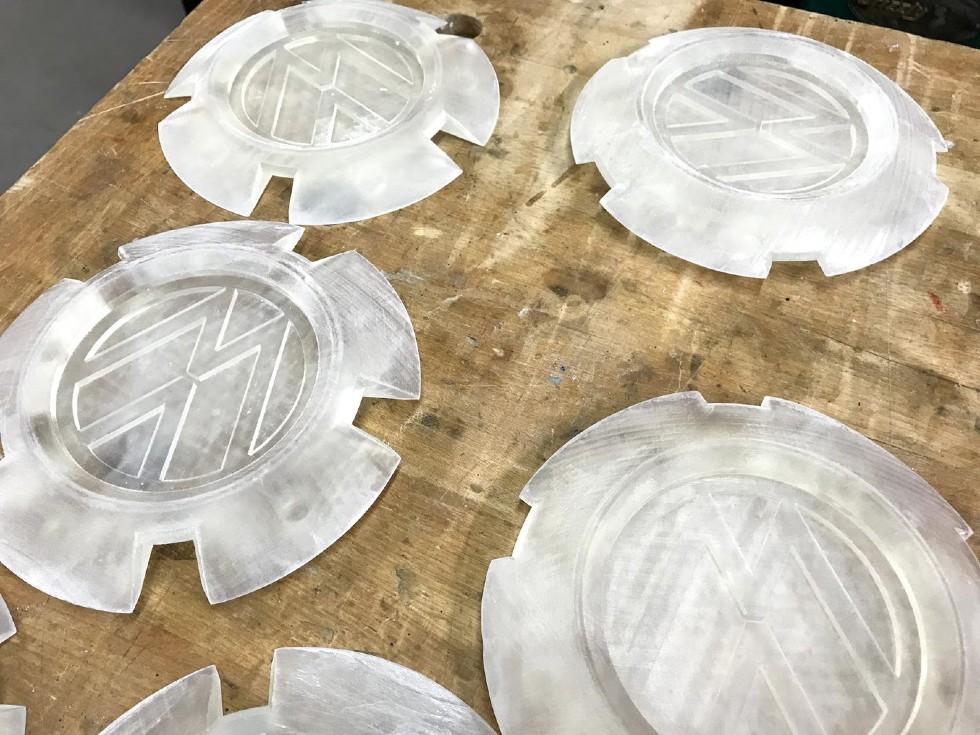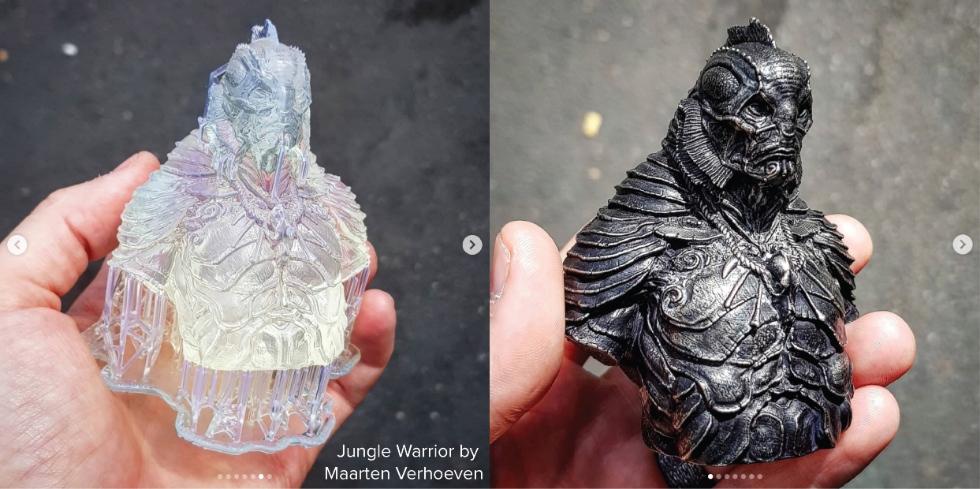- FMA
- The Fabricator
- FABTECH
- Canadian Metalworking
Our Publications
Categories
- Additive Manufacturing
- Aluminum Welding
- Arc Welding
- Assembly and Joining
- Automation and Robotics
- Bending and Forming
- Consumables
- Cutting and Weld Prep
- Electric Vehicles
- En Español
- Finishing
- Hydroforming
- Laser Cutting
- Laser Welding
- Machining
- Manufacturing Software
- Materials Handling
- Metals/Materials
- Oxyfuel Cutting
- Plasma Cutting
- Power Tools
- Punching and Other Holemaking
- Roll Forming
- Safety
- Sawing
- Shearing
- Shop Management
- Testing and Measuring
- Tube and Pipe Fabrication
- Tube and Pipe Production
- Waterjet Cutting
Industry Directory
Webcasts
Podcasts
FAB 40
Advertise
Subscribe
Account Login
Search
Filling the gap between plastic and metal 3D printing
Electroplating 3D-printed plastic parts is a cost-effective alternative to printing with metal
- By Holly B. Martin
- August 7, 2020
- Article
- Additive Manufacturing

Formlabs 3D-printed plastic hubcaps for a special-edition VW microbus. RePliForm electroplated the hubcaps. Formlabs
Electroplating can turn a 3D-printed plastic part into a highly functional end-use part, according to Formlabs’ Analisa Russo.
The company’s technical community manager first got involved with electroplating additively manufactured parts while working on a project to re-create a version of Volkswagen’s 1962 microbus.
VW and Autodesk designed hubcaps to be 3D-printed for the vehicle. Next, Russo’s team at Formlabs, Somerville, Mass., printed the hubcaps on stereolithography (SLA)-style 3D printers. Then RePliForm, a custom electroplating shop in Halethorpe, Md., applied a 0.004-in.-thick layer of copper and nickel to the surface.
The resulting parts look and feel like metal. But compared to 3D-printed metal hubcaps, the plastic resin/plated versions could be produced as quickly as the design evolved and with minimal geometric constraints.
Electroplating 3D-printed resins is a good option for any number of applications. “The strength and stiffness data for an electroplated resin nicely fills in that big gap between plastics and metals,” said Russo.
Besides automotive devices, the hybrid technique can be used for making manufacturing fixtures, which need to maintain dimensional stability over time, and to lightweight electrical parts such as antennas.
“Antennas are a beautiful example of combining the geometric complexity of 3D printing with the functionality of the metal coating,” said Russo. “We’ve already seen some antenna designs with really complex internal channels that can only be made through 3D printing, followed by high-purity, highly conductive copper coatings,” she said.
The founder and CEO of RePliForm, Sean Wise, has been electroplating SLA parts since 2002. Tests conducted by his company show that electroplating increases the tensile strength of SLA prints threefold, flexural strength nearly tenfold, and stiffness fourfold.
“People don’t realize how strong electroplated coatings can be,” said Wise. “We can get a very robust part because we’re making a composite with a metal outer skin that is 10 to 15 times stronger than the plastic substrate.”
As for costs, electroplating a plastic part with 50 to 75 microns of a noncosmetic copper-and-nickel coating would be roughly the same price as the retail cost of a printed plastic part from a service bureau, said Wise. He added that other factors would raise or lower the cost, and the plating outlay would be less as part volumes rose.
Wise estimated that ordering four SLA parts plated with 50 microns of copper and nickel would cost a total of $456 versus $1,600 for four 3D-printed stainless steel parts.
Surface Finishing
Wise said that when appearance is critical, parts printed by SLA technology are better suited to electroplating than those printed by selective laser sintering or filament-style methods. He added that his shop plates parts printed by all three technologies.
“A real advantage of stereolithography is that you get tremendous resolution with the UV laser curing a photopolymer resin,” said Wise. “It’s a good place to start if you’re after something with a nice controlled finish, whether it be a fine texture or a very smooth surface.”
However, problems can arise when applying a thin plating of metal over the printed part. One is that the shiny metal surface highlights even the tiniest imperfection, including layer lines and other artifacts left over from the printing process.
“With SLA printing you always have a support scaffolding attaching the part to the build platform,” Russo explained. “Normally these are removed with snipping and sanding down the support points, and those artifacts remain even after the structure is removed. “I learned the hard way that electroplating is going to highlight even the most subtle surface defects and make them very high contrast,” she continued. “To prevent those marks from showing on cosmetic surfaces, it’s important to orient the part in the printer to hide them in an area where they won’t be visible during end use.”
Electroplating Steps
According to Wise, surface flaws can be masked with primer followed by conductive paint. The downside, though, is that fine or delicate features will be lost. To prevent this, while also forming a better bond with the resin, his shop uses a room-temperature electroless nickel (RTEN) process to plate directly on the plastic part. This is a standard production process used on plated injection-molded parts.
“First you put a palladium dispersion on the surface of the part,” said Wise. “Then you put the part in an RTEN tank containing a reducing agent in the presence of nickel ions, and it automatically starts depositing nickel on the surface.”
Once the metal completely covers the object, it’s possible to run an electric current through it. This is essential for the first electroplating step: a copper bath. In the bath, a power supply running through the part reduces the copper ions in the solution so that they plate-out as copper metal on the part. The rate at which they reduce is dependent upon the current density on the surface.
“The current density is highest on the outside of the most-protruding areas of the parts, and it’s lowest on the internal corners and the least-protruding areas of the parts,” Wise said. The result is “you get differential rates of deposition.” This can become an issue, especially when plating a part such as an antenna, which has interior surfaces that need to be plated.
The benefit of using copper first is that it is a good interfacial layer for the plastic. It tends to adhere a little better, and the plating will get into the fine details and in the corners much better than nickel.
After the copper layer, one or more different types of metal may be plated onto the piece, depending on the desired properties. For example, nickel is much stronger and more corrosion-resistant than copper, so it is usually applied after the copper. Other finishes, such as gold, silver, or chrome, can then be applied as a final cosmetic layer.
Design for Coating
Before printing a part that will ultimately be coated, it’s important to take into consideration the electroplated coating thickness and other factors.
“The coating will add a fairly uniform shell around your part that could be anywhere between 25 and 300 microns thick, depending on the application,” Russo said. “So you need to make a proper offset for that shell in your CAD model.”
She added that designing a part is a collaborative effort and an iterative process, making it important for additive manufacturers to work with electroplaters before printing.
“When somebody submits a part for us to quote, we ask questions about what the coating is for, how strong it needs to be, what type of surface is required, and what temperatures it will see,” said Wise.
“There are times when we tell people we just can’t do this, and other times that it’s relatively easy to do as long as everybody plans ahead,” he said.
About the Author

Holly B. Martin
About the Publication
- Podcasting
- Podcast:
- The Fabricator Podcast
- Published:
- 04/16/2024
- Running Time:
- 63:29
In this episode of The Fabricator Podcast, Caleb Chamberlain, co-founder and CEO of OSH Cut, discusses his company’s...
- Trending Articles
- Industry Events
16th Annual Safety Conference
- April 30 - May 1, 2024
- Elgin,
Pipe and Tube Conference
- May 21 - 22, 2024
- Omaha, NE
World-Class Roll Forming Workshop
- June 5 - 6, 2024
- Louisville, KY
Advanced Laser Application Workshop
- June 25 - 27, 2024
- Novi, MI





























